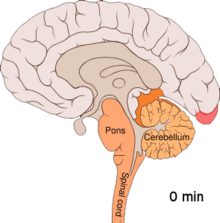
Back خمود قشري منتشر Arabic Streudepolarisierung German Rozszerzająca się depresja korowa Polish Depressão cortical alastrante Portuguese Expansiunea depresiei corticale Romanian

| Migraine |


Cortical spreading depression (CSD) or spreading depolarization (SD) is a wave of electrophysiological hyperactivity followed by a wave of inhibition.[1] Spreading depolarization describes a phenomenon characterized by the appearance of depolarization waves of the neurons and neuroglia[2] that propagates across the cortex at a velocity of 1.5–9.5 mm/min.[3][4][5][6]
CSD can be induced by hypoxic conditions and facilitates neuronal death in energy-compromised tissue.[7] CSD has also been implicated in migraine aura, where CSD is assumed to ascend in well-nourished tissue and is typically benign in most cases, although it may increase the probability in migraine patients to develop a stroke.[8]
Spreading depolarization within brainstem tissues regulating functions crucial for life has been implicated in sudden unexpected death in epilepsy, by way of ion channel mutations such as those seen in Dravet syndrome, a particularly severe form of childhood epilepsy that appears to carry an unusually high risk of SUDEP (sudden unexpected death in epilepsy).
Although the terms cortical spreading depression and spreading depolarization are often used as synonyms, a study found spreading depolarizations can produce variable effects on cortical activity in humans and rats, ranging from depressed to booming activity depending on SD depth.[9]
- ^ Dodick DW & Gargus JJ (August 2008). "Why migraines strike". Scientific American.
- ^ Chuquet, Julien; Hollender, Liad; Nimchinsky, Esther A. (2007-04-11). "High-resolution in vivo imaging of the neurovascular unit during spreading depression". The Journal of Neuroscience. 27 (15): 4036–4044. doi:10.1523/JNEUROSCI.0721-07.2007. ISSN 1529-2401. PMC 6672520. PMID 17428981.
- ^ Ayata, Cenk; Lauritzen, Martin (2015-07-01). "Spreading Depression, Spreading Depolarizations, and the Cerebral Vasculature". Physiological Reviews. 95 (3): 953–993. doi:10.1152/physrev.00027.2014. ISSN 1522-1210. PMC 4491545. PMID 26133935.
- ^ Hartings, Dreier; Jed, Jens (2017-05-01). "Recording, analysis, and interpretation of spreading depolarizations in neurointensive care: Review and recommendations of the COSBID research group". Journal of Cerebral Blood Flow and Metabolism. 37 (5): 1595–1625. doi:10.1177/0271678X16654496. ISSN 1559-7016. PMC 5435289. PMID 27317657.
- ^ Santos, Edgar; Schöll, Michael; Sánchez-Porras, Renán; Dahlem, Markus A.; Silos, Humberto; Unterberg, Andreas; Dickhaus, Hartmut; Sakowitz, Oliver W. (2014-10-01). "Radial, spiral and reverberating waves of spreading depolarization occur in the gyrencephalic brain". NeuroImage. 99: 244–255. doi:10.1016/j.neuroimage.2014.05.021. ISSN 1095-9572. PMID 24852458. S2CID 1347927.
- ^ Porooshani H, Porooshani GH, Gannon L, Kyle GM (2004). "Speed of progression of migrainous visual aura measured by sequential field assessment". Neuro-Ophthalmology. 28 (2): 101–105. doi:10.1076/noph.28.2.101.23739. S2CID 72813214.
- ^ Dreier, Jens P.; Reiffurth, Clemens (2015-05-20). "The stroke-migraine depolarization continuum". Neuron. 86 (4): 902–922. doi:10.1016/j.neuron.2015.04.004. ISSN 1097-4199. PMID 25996134.
- ^ Santos, Edgar; Sánchez-Porras, Renán; Dohmen, Christian; Hertle, Daniel; Unterberg, Andreas W.; Sakowitz, Oliver W. (2012-04-01). "Spreading depolarizations in a case of migraine-related stroke". Cephalalgia: An International Journal of Headache. 32 (5): 433–436. doi:10.1177/0333102412441414. ISSN 1468-2982. PMID 22407661. S2CID 25190650.
- ^ Nasretdinov, Azat; Vinokurova, Daria; Lemale, Coline L.; Burkhanova-Zakirova, Gulshat; Chernova, Ksenia; Makarova, Julia; Herreras, Oscar; Dreier, Jens P.; Khazipov, Roustem (25 November 2023). "Diversity of cortical activity changes beyond depression during Spreading Depolarizations". Nature Communications. 14 (1): 7729. doi:10.1038/s41467-023-43509-3. PMC 10676372. PMID 38007508.
© MMXXIII Rich X Search. We shall prevail. All rights reserved. Rich X Search